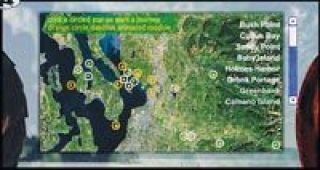TULALIP Students in the Marysville School District have a new tool to learn about Indian culture, thanks to the Tulalip Tribes.
A new online learning Web site was created by the Tribal computer department to augment the curriculum at Tulalip Elementary School and to comply with the mandates of new state legislation requiring a local angle for Native American history lessons wherever practical.
The Web site at www.tulaliplearningjourney.org centers around characters of two kids who travel through time on a magical canoe. The trips take them to important sites around the Puget Sound and show how the many tribes lived over hundreds of years, moving with the seasons and following the fish and game they ate. The journey starts with a visit to the Tulalip longhouse where Tribal elder Ray Moses asks them to make the trek for the sake of preserving the Tribes culture.
The characters, Nate and Kayla, accept the challenge and are soon paddling through a fog bank; in one scenario they emerge in an estuary where a fish trap has been set across a stream to capture salmon. Other scenes are accessed through a map of Puget Sound covered with circles. The dots cover the map like a shotgun spray and remind students that the various tribes that now comprise the Tulalip confederation were once spread throughout the region, north and south of the present reservation. Each dot is a click-able lesson taking the pair to a geographical area or a historical era, depending on the curriculums objective. They all lead to material for further study, according to David Cort, a teacher at Tulalip Elementary School who demonstrated the site at a joint meeting of the Tribal and school district boards on Jan. 22.
The mission was inspired by stories we heard, Cort told the boards. This shows what online learning can do for young people.
Sheryl Fryberg is the executive director of the Tulalip health and human services department who is leading with the project, developed by graphics guru Mandy Carter of the Tulalip data services department.
The elders were very excited, Fryberg told the boards. Some of them had tears in their eyes.
Carter is a Tulalip Indian who did the graphics for the interactive site, while Cort worked on the story line and syllabus. Last week Carter visited Corts classroom at Tulalip Elementary and got to see her handiwork in action. Student Anthony Cooper used the mouse to take his fellow students on a trip back in time where they learned how coastal Indians made longhouses.
OK, Anthony, take us to Warm Beach, Cort instructed. Cooper clicked on a dot on the map and the two characters drifted through a fogbank and landed on a beach with a steep cliff at Sandy Point. On the cliff were bare longhouse frames looking like huge soccer goals made of logs three feet in diameter. Puzzled by this wooden Stonehenge, Nate and Kayla hid and watched members of the Snohomish band as they clad the frame with cedar planks.
The frames were made of huge logs and left standing for all seasons, and tribes would cover them with walls of cedar planks up to five feet wide as they needed shelter. The planks were lashed to the frames with rope, wedged between poles, and the shell components would travel with the Indians as they paddled around Puget Sound. In the corner of Corts classroom was a mockup of boards, poles and lashings.
Next Cort led the class in a reading component where they discussed the different parts of the longhouses. After they read a paragraph reinforcing the video, Cort explained how the writing was fiction but that it could still relay truthful information.
This is a fictional narrative thats teaching us, he said. The characters were made up but the activities they watched actually happened, not far from the school on Tulalip Bay. During the computer lesson the students were still and attentive; the usual fidgeting didnt start until the discussion afterwards. A sign of the times perhaps was the fact that Corts classroom doesnt have a chalkboard, just a small dry marker board and the electronic whiteboard that dominates the room.
Since the students sat through a double lesson, their reward was playing the elk hunting game, another module of the online curriculum. Tribal member Jaida Maltos used the mouse to score three points out of 40 possible, albeit the 10-year-old was distracted by Cort as he interrupted to show the class new features he and Carter were working on. Maltos said she liked the web lessons.
You learn a lot about houses back then, and it brings me back to here, how houses are built now, Maltos said.
Students have new tool to study Indian culture
TULALIP Students in the Marysville School District have a new tool to learn about Indian culture, thanks to the Tulalip Tribes.



